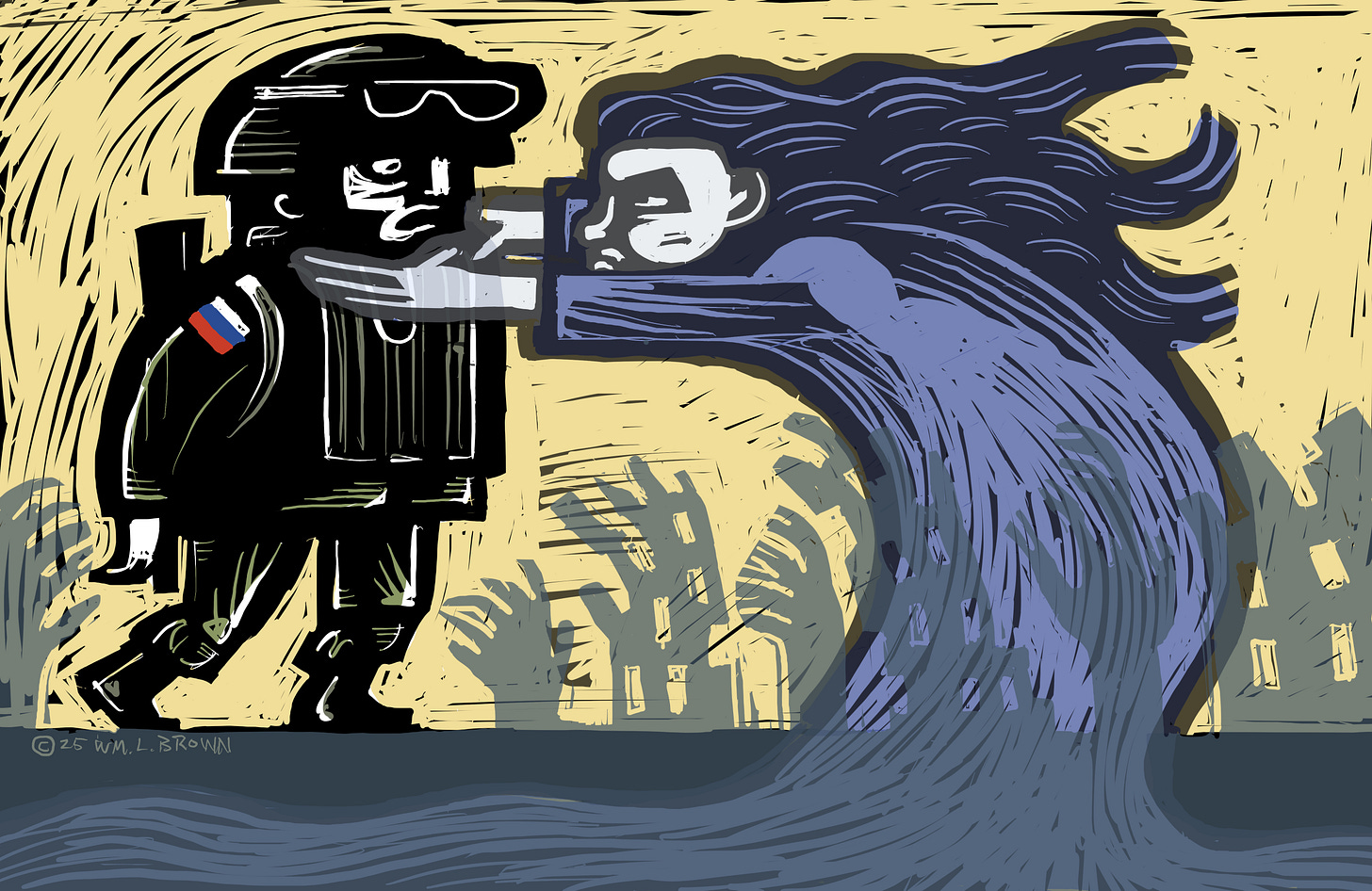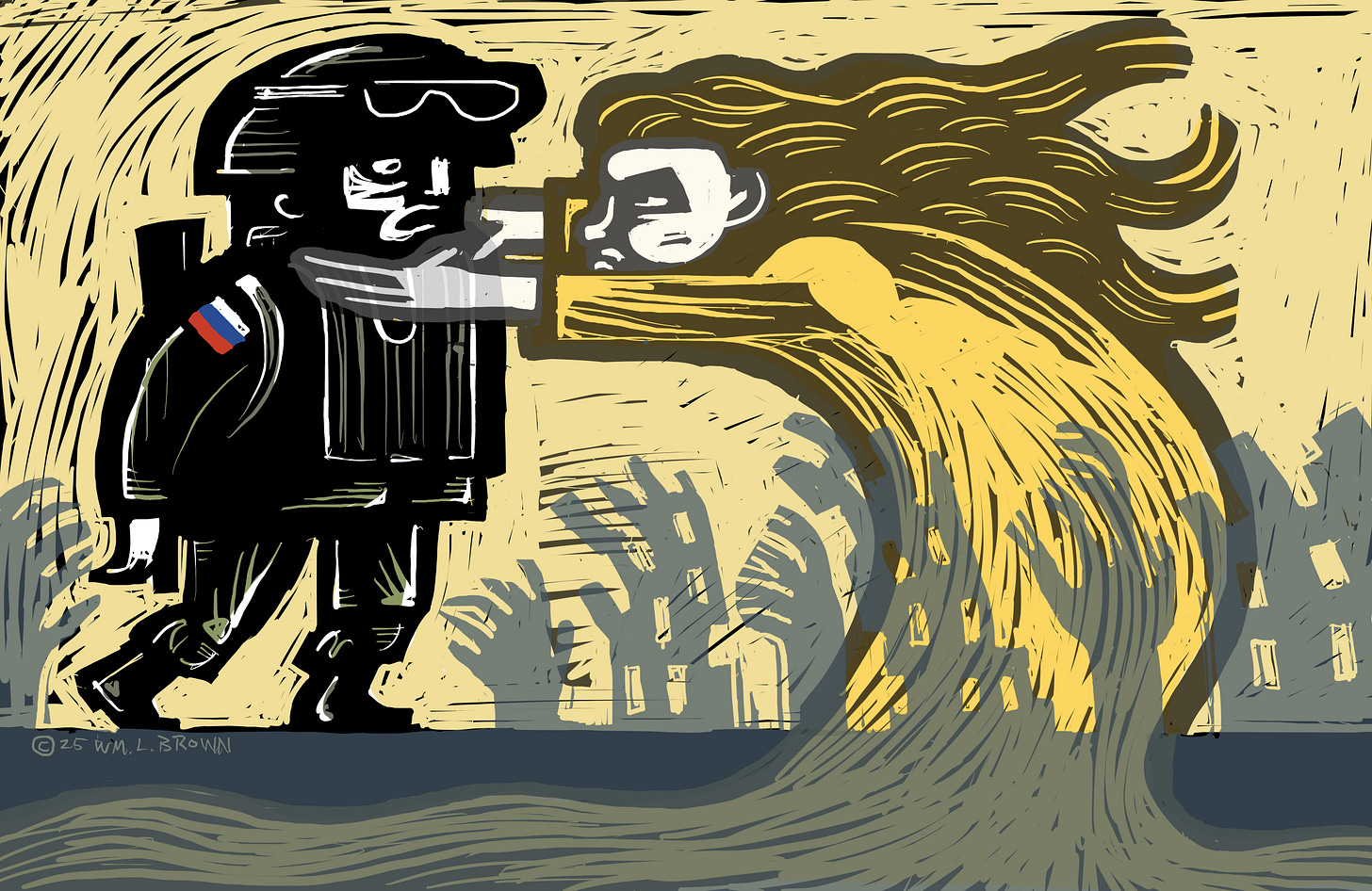Resistance, ©2025 William L. Brown.
Ukrainian underground resistance in Russian-occupied regions has been busy with harassment, sabotage, assassinations and attacks since the 2014 invasion. The Kyiv Post recently published an interview with saboteur, demolitionist, and Hero of Ukraine Volodymyr Zhemchuhov. The second half of the interview is here.
Following the 2014 invasion of Zhemchuhov’s Luhansk region, a resistance formed, dividing, he says, into two groups: partisans and the underground.
Partisans were those who decided to start armed resistance. In Krasnodon—two people, in Rovenky—three people, Sverdlovsk—four, Antratsyt—five, Krasny Luch—four, Lutuhyne—two, Luhansk—three, Snizhne—four. For a region—not many. But the underground included thousands, people tracking Russian movements, making patriotic graffiti, collecting data on collaborators and Russian positions.
At first, Russians denied to the world that they had invaded Ukraine. The troops and military hardware had no insignias.
But the Russian army hid behind local proxies, concealed tanks and APCs in towns. Near our city, in a ravine, they had a whole camp.
This is our land. Since childhood, we knew every river, every pond. We took rifles and went to their camp at night. We crept in close – we knew the terrain. We just started shooting at the camp. Some emptied one magazine, others two. Then we pulled back.
That’s how our partisan movement began.
He took part in about 30 operations: road and railway bombings and several assassination attempts. On his last mission, he lost both hands in a minefield misstep, and was captured. He was released in a prisoner exchange in 2016.
The podcast Ukraine: The Latest reports ongoing resistance efforts every Friday.
A few examples…
Last Friday, they reported a May 18 arson attack on a Russian military site on the Arabat Spit, a barrier island off the coast of occupied Crimea in the Azov Sea. Before the invasion it was a summer-resort area, much like America’s barrier islands along the southern Atlantic Coast. The military site is a former resort, now serving as a recreational facility for soldiers. They are banned from mixing with the natives who have a tendency to poison their food and drink.
On May 20 in the occupied Kherson region, the podcast reports, partisans blew up a vehicle carrying ammunition and weapons, killing four Russian soldiers. May 23 a drone hit the home of a collaborator appointed by Russians to act as mayor of a town in Zaporizhia. On the same day, same area, a partisan-launched drone struck a military vehicle on a busy Russian supply route, killing four occupiers. The road is frequently the target of partisan sabotage.
A grenade assassination was carried out May 29 by a Mariupol resistance group against a Russian air-force major and former commander in the bloody assault and occupation of Mariupol. He had received state honors for his key role in guiding air strikes.
Resistance acts are not always deadly. Some involve sowing Russian supply routes with steel spikes to puncture tires, derailing trains, sabotaging railroad relay boxes, or graffitiing and information-gathering.
As sometimes happens, I do more than one color-treatment of my drawings. More than once, I changed my mind after sending the drawing to the Tribune news syndicate, posting another version to Native Cpeaker. Which of these do you prefer?
Posh
Ukraine: The Latest is published by British newspaper The Telegraph. One of the presenters is producer and journalist Adélie Pojzman-Pontay. She is French. She was affianced to the podcast’s late founder David Knowles, whose sudden, unexpected death in 2024 at the tender age of 32 was a great tragedy. Adélie the producer moved from behind the microphone to a presenter role.
She gave a brief personal assessment of her new role in the June 4 episode last week, thanking listeners for their support of her in the new role, but noting that listener feedback included complaints about her “posh” English accent. She finished her remarks in a facetiously thick French-accented English for the sake of her critics.
So, here I’m going to lapse into the “English lesson,” as I sometimes warn my students. I assure you as I assure them that it really is terribly interesting. They don’t believe me, either.
By “posh” the commenters mean what is known as “Received Pronunciation” in English instruction. It’s an old fashioned term these days, subject to much academic scorn and disagreement. The purpose of it was to sound upper-class, educated, and devoid of regional accent or colloquialism. This was useful for people in the radio business where it (or a version of it) was called “The BBC Accent.” It is also referred to as “The Queen’s (or King’s) English” depending on the British Throne’s gender preference. It was taught to foreign-language speakers as “correct English.” It still is in some places.
The US equivalent of Received Pronunciation is the Standard American or General American English accent. I was brought up with that, probably you were, too. Our educators and parents wanted us to sound educated and with no obvious regionalisms.
As a result, children learn to “code-switch,” use different accents, colloquialisms, even languages, depending on the social situation. Standard/General American is for professional work, speaking to social superiors or officials, and formal occasions. Informally, with friends, families and neighbors, we slip into a more relaxed English laced with accents, contractions, elisions, colloquialisms, grammar-bending and colorful words.
I did this as a child, and since moving back to my native New Hampshire, I find the skill is still there, like learning to ride a bicycle.
The reality of English is that it is a patchwork of thousands of such regional and class accents from London to Delhi. Kingston, New Orleans and Vancouver.
There is a brilliantly funny series of instructional videos from an Italian/British language teacher Aurora of Aurora’s Online English Lessons. She teaches the English accents and phrases foreign visitors need in public situations such as shopping for groceries, navigating a train-station, or ordering at a cafe. She plays both parts: the foreigner and the native-speaker. She perfectly portrays the wide-eyed panic of the foreigner confronted with undecipherable phrases. More to the point, she illustrates how everyday, informal British English is an impenetrable thorn-bush of elisions and contractions (don’cha’no?).
My students just want to learn “correct English.” They don’t care for the explanation that Received Pronunciation in the UK or General American in the US are artificial constructs and that all regional or class variations are legitimate in their own right.
Yeah, no, they want to learn correct English because they want a better job. The reality is is that English speakers, especially “well-spoken” English speakers get higher-paying jobs. English is a privilege, a fact the world understands much more keenly than most Americans.
My way around this as an English instructor is to show video examples of several English speakers from such locations as Scotland, Boston, Liverpool, Atlanta, South Africa, and India. I don’t expect them to learn to speak like that, I tell them.,“but you do need to know that they are all speaking correctly, and it’s on you to adjust and understand them, not complain that they are wrong.”






Very interesting post, as usual. I like both of the illustrations, but find the yellow one more luminous and appealing.
Glad to hear you have moved back to NH. I greatly envy you that. I am currently residing in Wisconsin.
I loved this article today.
Your old friend.
G Kretschmar